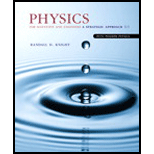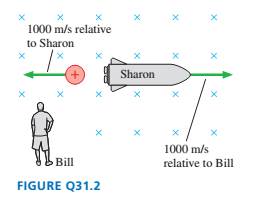
Physics for Scientists and Engineers: A Strategic Approach with Modern Physics (4th Edition)
4th Edition
ISBN: 9780133942651
Author: Randall D. Knight (Professor Emeritus)
Publisher: PEARSON
expand_more
expand_more
format_list_bulleted
Concept explainers
Textbook Question
Chapter 31, Problem 2CQ
Sharon drives her rocket through the magnetic field of FIGURE Q31.2 traveling to the right at a speed of
a. According to Bill, what kind of force or forces act on the charge? In which directions? Explain.
b. According to Sharon, what kind of force or forces act on the charge? In which directions? Explain.

Expert Solution & Answer
Want to see the full answer?
Check out a sample textbook solution
Students have asked these similar questions
Please solve and answer this problem correctly please. Thank you!!
Please solve and answer this problem correctly please. Thank you!!
a) Use the node-voltage method to find v1, v2, and
v3 in the circuit in Fig. P4.14.
b) How much power does the 40 V voltage source
deliver to the circuit?
Figure P4.14
302
202
w
w
+
+
+
40 V
V1
80 Ω 02
ΣΑΩ
28 A
V3 +
w
w
102
202
Chapter 31 Solutions
Physics for Scientists and Engineers: A Strategic Approach with Modern Physics (4th Edition)
Ch. 31 - Prob. 1CQCh. 31 - Sharon drives her rocket through the magnetic...Ch. 31 - If you curl the fingers of your right hand as...Ch. 31 - What is the current through surface S in FIGURE...Ch. 31 - Is the electric field strength in FIGURE Q31.5...Ch. 31 - Do the situations in FIGURE Q31.6 represent...Ch. 31 - In what directions are the electromagnetic waves...Ch. 31 - The intensity of an electromagnetic wave is 10W/m2...Ch. 31 - Prob. 9CQCh. 31 - Prob. 10CQ
Ch. 31 - Prob. 1EAPCh. 31 - 2. A rocket cruises past a laboratory at in the ...Ch. 31 - Prob. 3EAPCh. 31 - Prob. 4EAPCh. 31 - Prob. 5EAPCh. 31 - Prob. 6EAPCh. 31 - Prob. 7EAPCh. 31 - Prob. 8EAPCh. 31 - Prob. 9EAPCh. 31 - Prob. 10EAPCh. 31 - Prob. 11EAPCh. 31 - Prob. 12EAPCh. 31 - Prob. 13EAPCh. 31 - Prob. 14EAPCh. 31 - Prob. 15EAPCh. 31 - Prob. 16EAPCh. 31 - Prob. 17EAPCh. 31 - Prob. 18EAPCh. 31 - Prob. 19EAPCh. 31 - Prob. 20EAPCh. 31 - Prob. 21EAPCh. 31 - Prob. 22EAPCh. 31 - Prob. 23EAPCh. 31 - Prob. 24EAPCh. 31 - Prob. 25EAPCh. 31 - Prob. 26EAPCh. 31 - Prob. 27EAPCh. 31 - Prob. 28EAPCh. 31 - Prob. 29EAPCh. 31 - Prob. 30EAPCh. 31 - Prob. 31EAPCh. 31 - An electron travels with <m:math...Ch. 31 - Prob. 33EAPCh. 31 - Prob. 34EAPCh. 31 - Prob. 35EAPCh. 31 - Prob. 36EAPCh. 31 - Prob. 37EAPCh. 31 - Prob. 38EAPCh. 31 - Prob. 39EAPCh. 31 - Prob. 40EAPCh. 31 - Prob. 41EAPCh. 31 - Prob. 42EAPCh. 31 - Prob. 43EAPCh. 31 - Prob. 44EAPCh. 31 - Prob. 45EAPCh. 31 - The electric field of a 450MHz radio wave has a...Ch. 31 - Prob. 47EAPCh. 31 - Prob. 48EAPCh. 31 - Prob. 49EAPCh. 31 - A LASIK vision-correction system uses a laser that...Ch. 31 - Prob. 51EAPCh. 31 - Prob. 52EAPCh. 31 - Prob. 53EAPCh. 31 - Prob. 54EAPCh. 31 - Prob. 55EAPCh. 31 - Prob. 56EAPCh. 31 - Prob. 57EAPCh. 31 - Prob. 58EAPCh. 31 - Prob. 59EAPCh. 31 - Prob. 60EAPCh. 31 - An electron travels with through a point in space...Ch. 31 - Prob. 62EAPCh. 31 - Prob. 63EAPCh. 31 - Prob. 64EAP
Knowledge Booster
Learn more about
Need a deep-dive on the concept behind this application? Look no further. Learn more about this topic, physics and related others by exploring similar questions and additional content below.Similar questions
- Please solve and answer this problem correctly please. Thank you!!arrow_forwardYou're on an interplanetary mission, in an orbit around the Sun. Suppose you make a maneuver that brings your perihelion in closer to the Sun but leaves your aphelion unchanged. Then you must have Question 2 options: sped up at perihelion sped up at aphelion slowed down at perihelion slowed down at aphelionarrow_forwardThe force of the quadriceps (Fq) and force of the patellar tendon (Fp) is identical (i.e., 1000 N each). In the figure below angle in blue is Θ and the in green is half Θ (i.e., Θ/2). A) Calculate the patellar reaction force (i.e., R resultant vector is the sum of the horizontal component of the quadriceps and patellar tendon force) at the following joint angles: you need to provide a diagram showing the vector and its components for each part. a1) Θ = 160 degrees, a2) Θ = 90 degrees. NOTE: USE ONLY TRIGNOMETRIC FUNCTIONS (SIN/TAN/COS, NO LAW OF COSINES, NO COMPLICATED ALGEBRAIC EQUATIONS OR ANYTHING ELSE, ETC. Question A has 2 parts!arrow_forward
- The force of the quadriceps (Fq) and force of the patellar tendon (Fp) is identical (i.e., 1000 N each). In the figure below angle in blue is Θ and the in green is half Θ (i.e., Θ/2). A) Calculate the patellar reaction force (i.e., R resultant vector is the sum of the horizontal component of the quadriceps and patellar tendon force) at the following joint angles: you need to provide a diagram showing the vector and its components for each part. a1) Θ = 160 degrees, a2) Θ = 90 degrees. NOTE: USE DO NOT USE LAW OF COSINES, NO COMPLICATED ALGEBRAIC EQUATIONS OR ANYTHING ELSE, ETC. Question A has 2 parts!arrow_forwardNo chatgpt pls will upvotearrow_forwardThe force of the quadriceps (Fq) and force of the patellar tendon (Fp) is identical (i.e., 1000 N each). In the figure below angle in blue is Θ and the in green is half Θ (i.e., Θ/2). A) Calculate the patellar reaction force (i.e., R resultant vector is the sum of the horizontal component of the quadriceps and patellar tendon force) at the following joint angles: you need to provide a diagram showing the vector and its components for each part. a1) Θ = 160 degrees, a2) Θ = 90 degrees. NOTE: USE ONLY TRIGNOMETRIC FUNCTIONS (SIN/TAN/COS, NO LAW OF COSINES, NO COMPLICATED ALGEBRAIC EQUATIONS OR ANYTHING ELSE, ETC. Question A has 2 parts!arrow_forward
- ་ The position of a particle is described by r = (300e 0.5t) mm and 0 = (0.3t²) rad, where t is in seconds. Part A Determine the magnitude of the particle's velocity at the instant t = 1.5 s. Express your answer to three significant figures and include the appropriate units. v = Value Submit Request Answer Part B ? Units Determine the magnitude of the particle's acceleration at the instant t = 1.5 s. Express your answer to three significant figures and include the appropriate units. a = Value A ? Unitsarrow_forwardSolve and answer the question correctly please. Thank you!!arrow_forwardSolve and answer the question correctly please. Thank you!!arrow_forward
arrow_back_ios
SEE MORE QUESTIONS
arrow_forward_ios
Recommended textbooks for you

 Physics for Scientists and Engineers: Foundations...PhysicsISBN:9781133939146Author:Katz, Debora M.Publisher:Cengage Learning
Physics for Scientists and Engineers: Foundations...PhysicsISBN:9781133939146Author:Katz, Debora M.Publisher:Cengage Learning College PhysicsPhysicsISBN:9781938168000Author:Paul Peter Urone, Roger HinrichsPublisher:OpenStax College
College PhysicsPhysicsISBN:9781938168000Author:Paul Peter Urone, Roger HinrichsPublisher:OpenStax College Physics for Scientists and EngineersPhysicsISBN:9781337553278Author:Raymond A. Serway, John W. JewettPublisher:Cengage Learning
Physics for Scientists and EngineersPhysicsISBN:9781337553278Author:Raymond A. Serway, John W. JewettPublisher:Cengage Learning Physics for Scientists and Engineers with Modern ...PhysicsISBN:9781337553292Author:Raymond A. Serway, John W. JewettPublisher:Cengage Learning
Physics for Scientists and Engineers with Modern ...PhysicsISBN:9781337553292Author:Raymond A. Serway, John W. JewettPublisher:Cengage Learning Glencoe Physics: Principles and Problems, Student...PhysicsISBN:9780078807213Author:Paul W. ZitzewitzPublisher:Glencoe/McGraw-Hill
Glencoe Physics: Principles and Problems, Student...PhysicsISBN:9780078807213Author:Paul W. ZitzewitzPublisher:Glencoe/McGraw-Hill


Physics for Scientists and Engineers: Foundations...
Physics
ISBN:9781133939146
Author:Katz, Debora M.
Publisher:Cengage Learning

College Physics
Physics
ISBN:9781938168000
Author:Paul Peter Urone, Roger Hinrichs
Publisher:OpenStax College

Physics for Scientists and Engineers
Physics
ISBN:9781337553278
Author:Raymond A. Serway, John W. Jewett
Publisher:Cengage Learning

Physics for Scientists and Engineers with Modern ...
Physics
ISBN:9781337553292
Author:Raymond A. Serway, John W. Jewett
Publisher:Cengage Learning

Glencoe Physics: Principles and Problems, Student...
Physics
ISBN:9780078807213
Author:Paul W. Zitzewitz
Publisher:Glencoe/McGraw-Hill
Magnets and Magnetic Fields; Author: Professor Dave explains;https://www.youtube.com/watch?v=IgtIdttfGVw;License: Standard YouTube License, CC-BY